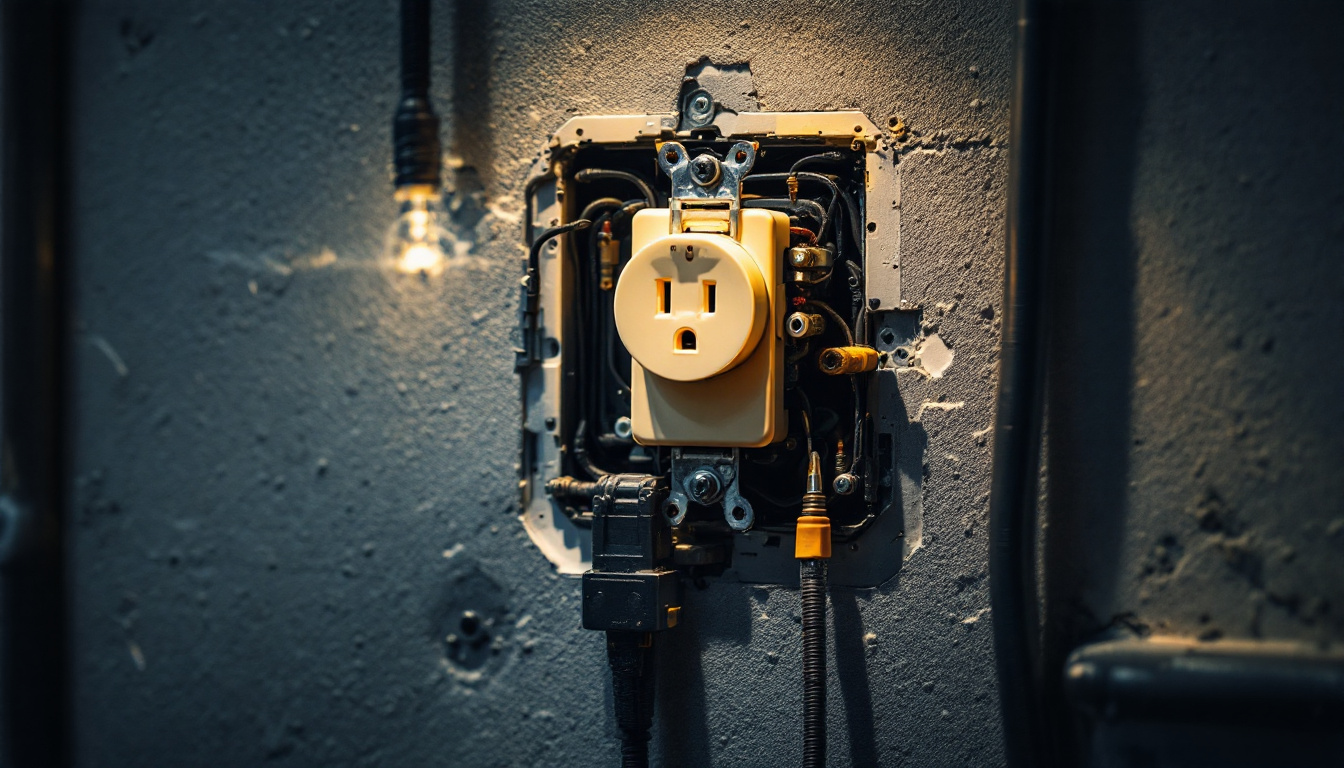
In the world of lighting installation, contractors often focus on the aesthetics, functionality, and energy efficiency of the fixtures themselves. However, one crucial component that frequently gets overlooked is the power receptacle. Understanding the importance of power receptacles can significantly impact the overall quality and reliability of lighting projects. This article delves into the common oversights regarding power receptacles and highlights best practices that can enhance the performance of lighting installations.
Power receptacles serve as the backbone of any electrical system, providing the necessary connection between the power source and the lighting fixtures. Their role is not merely functional; they also contribute to the safety and efficiency of the entire installation. A well-placed and properly rated receptacle can prevent issues such as overloads, flickering lights, and even electrical fires.
One of the most critical aspects that lighting contractors often overlook is the load requirements of the lighting fixtures being installed. Each fixture has a specific wattage rating, and when multiple fixtures are connected to a single receptacle, it is essential to calculate the total load accurately. Exceeding the receptacle’s load rating can lead to overheating and potential failure.
Contractors should always refer to the National Electrical Code (NEC) guidelines when determining load capacities. Additionally, considering future expansion or additional circuits can save time and resources in the long run. For example, if a contractor anticipates adding more fixtures or upgrading to higher-wattage models in the future, it is prudent to install receptacles that can accommodate these changes without necessitating a complete overhaul of the existing electrical system. This foresight not only enhances the longevity of the installation but also provides flexibility for evolving lighting needs.
Not all power receptacles are created equal. Depending on the specific lighting application, different types of receptacles may be required. For instance, outdoor lighting installations may necessitate weather-resistant receptacles, while high-wattage fixtures may require heavy-duty options.
Contractors should also consider the type of plug that will be used with the fixtures. Ensuring compatibility between the receptacle and the plug is crucial for maintaining a secure connection and preventing electrical hazards. Furthermore, the physical location of the receptacle plays a significant role in its effectiveness. For example, receptacles placed in areas prone to moisture, such as bathrooms or kitchens, must have ground fault circuit interrupter (GFCI) protection to mitigate the risk of shock. Similarly, in commercial settings where lighting may be adjusted frequently, using receptacles with quick-connect features can facilitate easier maintenance and upgrades, thereby enhancing operational efficiency.
Even experienced lighting contractors can make mistakes during the installation of power receptacles. Recognizing these common pitfalls can help avoid costly rework and ensure a safer installation.
The placement of power receptacles is often an afterthought, yet it plays a vital role in the functionality of the lighting system. Contractors should take into account the layout of the space and the intended use of the lighting. For example, receptacles should be positioned in accessible locations to facilitate easy maintenance and replacement of fixtures.
Additionally, receptacles should be placed away from potential hazards, such as water sources or areas with high foot traffic. Proper planning during the design phase can mitigate these issues and enhance the overall safety of the installation. Furthermore, considering the aesthetic aspects of receptacle placement can lead to a more visually appealing environment. For instance, aligning receptacles with furniture layouts or architectural features can create a seamless look that complements the overall design of the space.
Grounding is a critical safety feature that many contractors overlook when installing power receptacles. Proper grounding helps prevent electrical shock and protects equipment from surges. It is essential to follow local codes and regulations regarding grounding to ensure compliance and safety.
Contractors should also consider using GFCI (Ground Fault Circuit Interrupter) receptacles in areas where moisture is present, such as bathrooms and outdoor spaces. These receptacles automatically cut off power when a ground fault is detected, providing an additional layer of safety. In addition to GFCIs, utilizing surge protectors in conjunction with grounded receptacles can further safeguard sensitive electronic devices from voltage spikes, which is particularly important in home offices or entertainment areas where valuable equipment is used.
Another common oversight is failing to ensure that the circuit breakers are compatible with the installed power receptacles. Each receptacle type has specific requirements for circuit breakers, and using the wrong type can lead to nuisance tripping or, worse, electrical fires.
Contractors should verify that the circuit breakers are appropriately rated for the load and type of receptacle being installed. This attention to detail can prevent future complications and enhance the reliability of the lighting system. Additionally, it’s beneficial for contractors to educate clients about the importance of not overloading circuits, as this can lead to overheating and potential hazards. Providing guidance on how to distribute electrical loads evenly across multiple circuits can empower clients to make informed decisions about their power usage, ultimately contributing to a safer and more efficient electrical system.
To avoid common pitfalls and ensure a successful lighting installation, contractors should follow best practices when it comes to power receptacles. Implementing these strategies can lead to improved safety, efficiency, and overall satisfaction for clients.
Before beginning any installation, conducting a thorough load analysis is essential. This process involves calculating the total wattage of all lighting fixtures and ensuring that the selected receptacle can handle the load. A well-executed load analysis will help prevent overloads and ensure the longevity of the electrical system.
In addition to calculating current loads, contractors should also consider potential future loads. This proactive approach can save time and money by reducing the need for future upgrades or modifications. For instance, if a client plans to expand their space or add new fixtures in the coming years, anticipating these changes during the initial installation can prevent the inconvenience and expense of retrofitting or replacing receptacles later on.
The quality of materials used in the installation of power receptacles can significantly impact the performance and safety of the lighting system. Contractors should invest in high-quality receptacles that meet industry standards and are designed for the specific application.
Using reputable brands and materials not only ensures reliability but also enhances the overall aesthetic of the installation. Clients are more likely to appreciate the attention to detail and quality in their lighting systems. Additionally, opting for materials with enhanced features, such as weatherproof or tamper-resistant receptacles, can provide added safety and durability, particularly in commercial or outdoor settings where environmental factors may pose risks to electrical components.
Once the installation is complete, regular maintenance and inspections are vital for ensuring the continued safety and functionality of power receptacles. Contractors should establish a maintenance schedule that includes checking for signs of wear, loose connections, and any potential safety hazards.
Educating clients on the importance of regular inspections can also foster long-term relationships and ensure that the lighting system remains in optimal condition. This proactive approach can prevent costly repairs and enhance client satisfaction. Furthermore, providing clients with a checklist of maintenance tasks they can perform themselves, such as keeping receptacles free of dust and debris or monitoring for unusual smells or sounds, can empower them to take an active role in the upkeep of their electrical systems. Regular communication about the status of their installations can also reinforce trust and demonstrate a commitment to their safety and satisfaction.
The lighting industry is continually evolving, with new technologies emerging that can enhance the functionality and efficiency of lighting systems. Contractors should stay informed about these advancements and consider how they can be integrated into their installations.
smart lighting solutions are becoming increasingly popular, offering enhanced control and energy efficiency. When installing power receptacles for smart lighting systems, contractors should ensure that the receptacles are compatible with the technology being used.
Additionally, contractors should consider the placement of receptacles to accommodate smart devices and controls. This might involve installing receptacles in more accessible locations or integrating them into existing smart home systems.
As energy efficiency becomes a priority for many clients, contractors should explore energy-efficient receptacle options. These may include receptacles with built-in timers or sensors that can help reduce energy consumption.
By offering clients energy-efficient solutions, contractors can not only meet their needs but also contribute to sustainability efforts. This approach can enhance the contractor’s reputation and attract environmentally conscious clients.
Power receptacles are a critical component of any lighting installation, yet they are often overlooked by contractors. By understanding the importance of load requirements, proper placement, grounding, and circuit breaker compatibility, contractors can enhance the safety and efficiency of their projects.
Implementing best practices, conducting thorough load analyses, utilizing quality materials, and staying informed about emerging technologies will further elevate the quality of lighting installations. By prioritizing power receptacles, lighting contractors can ensure that their projects are not only visually appealing but also safe and reliable.
Ultimately, attention to detail in the installation of power receptacles can lead to improved client satisfaction and long-term success in the competitive lighting industry. Embracing these considerations will not only enhance the contractor’s expertise but also contribute to the overall safety and functionality of lighting systems.
Don’t let overlooked details like power receptacles compromise your lighting installations. At LumenWholesale, we provide lighting contractors with the highest quality, spec-grade lighting products at exceptional wholesale prices. Our commitment to cutting out the middleman means you get the best value without unnecessary markups. With our extensive selection that meets rigorous industry standards, you can trust that your projects will be safe, reliable, and aesthetically pleasing. Plus, with free shipping on bulk orders, you can stock up on premium lighting essentials without worrying about hidden fees. Elevate your lighting installations today and experience the unbeatable combination of quality, affordability, and convenience at LumenWholesale – Wholesale Lighting at the Best Value.

Discover essential insights into dusk to dawn recessed lighting with our comprehensive guide tailored for lighting contractors.

Discover the essential compliance requirements for lighting contractors in this comprehensive guide.

Discover the often-overlooked aspects of outdoor patio light fixtures that even seasoned lighting contractors miss.

Explore innovative strategies and cutting-edge technologies employed by smart lighting contractors to optimize battery usage in modern lighting systems.